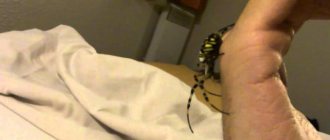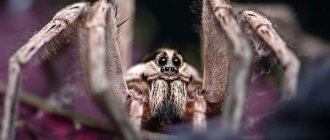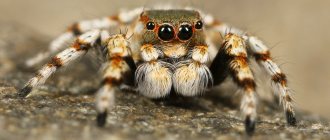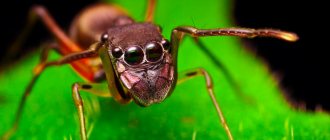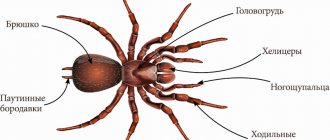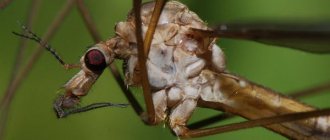Brown recluse spider
In appearance, the hermit does not seem very scary, but still causes unpleasant sensations. And for good reason, since this 2-centimeter “baby” is very poisonous. Its bite leads to the death of the affected tissues, and in rare cases even to death. Hermit spiders live in the southern United States, often choosing barns, garages and basements for their homes. They do not attack people first, but if a spider is accidentally crushed, a poisonous bite is guaranteed to a person.
The most dangerous spiders in the world
Deadly spiders include the Brazilian spider, the redback spider, and the Chilean recluse, described above, as well as the Sydney funnel-web spider, the brown recluse. In addition, humans should be wary of such arachnid species as Phoneutria fera, the six-eyed sandpiper.
Sydney funnel web spider
Sydney funnel-web spider has long, strong fangs, thanks to which it bites not only skin, but also nails. The large arachnid attacks quickly and furiously.
Before attacking, the predator raises its paws up and shows its fangs. These are the most dangerous spiders, because they can inflict several bites at a time. For children, the venom of the funnel-web arthropod is fatal.
Muscle twitching occurs at the site of the bite. The area then goes numb. Due to intoxication, a person experiences shortness of breath, excessive lacrimation and salivation. Sometimes people fall into a comatose state.
Brown recluse spider
Loxosceles reclusa lives in the Eastern United States. The paw span of the animal is 2 centimeters. There are small hairs on the limbs and abdomen of the predator.
The hermit has 6 pairs of eyes. The animal weaves webs in crevices, firewood, and mouse holes. At night, the brown recluse hunts small insects, and during the day it hides in dark places.
Although Loxosceles reclusa is very strong, it rarely attacks humans. Even if he bites, no pain is felt. But fever and nausea may occur.
Brazilian wandering spider
Phoneutria fera are deadly spiders. Their habitat is Central or South America.
Arachnids are quite large. Their body length is up to 12 centimeters. Moreover, females are larger than males.
Phoneutria fera received its name due to its wandering lifestyle. The animal does not unravel the web and changes its region of residence.
Since the predator often lays eggs on bananas, it is also called the banana spider. The predator feeds on insects and can bite mice and birds.
The venom of the Brazilian predator is deadly. It causes severe allergies. A couple of hours after the bite, the victim may die from suffocation.
Six-eyed sand spider
Sicarius hahni releases a special necrotic toxin when bitten. The poison destroys vascular walls and red blood cells. Therefore, people can die due to internal bleeding.
The Greater Six-Eyed Sandstone lives in Africa and South America. For the home of Sicarius hahni, the predator chooses sand dunes, stones, and trees.
The large body of the arachnid is slightly flattened. The length of the body is up to 15 mm, and the span of the legs is up to 5 cm.
The predator has 6 eyes on its head. The color depends on the area where it lives. It can be brown, red or yellow. Externally, the animal resembles a crab.
Therefore, when visiting southern countries such as America, Africa, Australia, it is important to exercise caution and immediately seek medical help if bitten by any spider.
Linotele fallax
This spider is called a tiger spider for its similarity in color to a mammalian predator. Its body is approximately 4 cm in length, and with its paws spread it reaches 10-12 cm. These “tigers” are found in Bolivia. They dig deep holes for themselves, entangling them with an incredibly thick web, like something out of a horror movie. Despite its terrifying appearance, linotele fallax is popular among spider lovers, and is often kept as a pet.
Brazilian wandering spider
He has many names: banana spider, soldier, runner. This large, palm-sized, hairy spider looks menacing. He is especially scary in anger, or more precisely, when he is angry and ready to attack. At this moment, he takes a fighting stance, raising his front paws up, and demonstrates his poisonous red jaws. The Brazilian wanderer lives in South and Central America. Considering the fact that it is considered the most poisonous spider on the planet, it is better to try not to meet it.
Phryn flagellated spider
This is exactly the case when appearance does not correspond to reality. Phryn is an absolutely harmless spider to humans. Its frightening appearance is given by disproportionately long, thin paws, the span of which can reach 25-30 cm, and large pedipalps with spikes, reminiscent of crab claws. These arachnids live in the tropics and subtropics. People rarely see them because they have a cowardly character and prefer to be nocturnal.
Camel spider, also known as the wind scorpion and salpuga
The spider grows up to 7 cm, and taking into account the straightened legs - up to 15 cm. Pale yellow color, chelicerae similar to a toothed bird beak or crab claws, hairy legs and a thick belly - all this makes the camel spider scary and unpleasant to look at. The picture is completed by the nasty squeak that he makes when attacked. It is better to avoid this inhabitant of the steppes and deserts. Although it is not poisonous, it can cause a painful bite even through a human fingernail.
Varieties
Yellow spider.
It has a golden color and is no larger than 10 mm in size. They usually live in Europe. Due to its size and unsightly color, it can remain in the house for a long time and be completely unnoticeable. In nature, they build their own house in the form of a pipe bag. Their bites are dangerous and cause necrotic wounds. They do not attack first, but in self-defense their bite will be such that it will not seem a little. Brazilian spider. He does not release a web and does not catch his prey in it. He cannot stop in one place, which is why he is called a wandering wanderer. The most important habitat of such arthropods is South America. Its bite cannot lead to death, as there is an antidote. But still, a bite can cause a severe allergic reaction. It has a sandy coloration, which allows it to hide in nature. The favorite pastime of these spiders is crawling in a basket of bananas, which is why it is nicknamed the “banana spider.” It can feed on other spiders, lizards and even birds that are much larger than it.
Brown recluse. This species is also dangerous to humans. He is not aggressive and rarely attacks, but his “neighborhood” should be avoided. If a bite by such an arachnid occurs, the person must be urgently sent to the hospital, as the poison spreads throughout the body within 24 hours. Such arthropods are usually small in size from 0.6 to 2 cm and love places such as the attic, closet, and the like. Their most common habitat is California and other US states. Their most important distinguishing feature is their furry “antennae” and three pairs of eyes, when all the others have mostly four pairs.
Black Widow. This is the most dangerous spider in the world. But the most important poisonous individual is the spider, since after mating it kills the male. They have very strong venom and are 15 times more lethal than rattlesnake venom. If a person is bitten by a female, then an antidote urgently needs to be administered within 30 seconds. Females spread in many places - in deserts and prairies. Their size reaches two centimeters.
Tarantula. This is the most beautiful and largest species of this individual; usually they are not too dangerous for humans. Their color can be varied - it can be from gray-brown to bright orange, and sometimes they are striped. They feed on small birds, despite their size of three to four centimeters. They try to live in steppes and deserts, digging themselves rather deep, damp burrows. They usually hunt at night, as they see very well in the dark. They are very often bred at home, considering that it is possible to breed snakes at home, but why not?
Water spiders. This name gave them the fact that they can live under water. They live in water bodies of Northern Asia and Europe. These individuals are small (reach only 1.7 cm), but they swim well and weave webs underwater among various algae. This species is completely harmless to people, as it eats small crustaceans and larvae. Its poison is too weak and therefore does not cause much harm to humans.
Crab spider. There are about three thousand such species in nature. Their color, size and beauty are very diverse. It can calmly merge with nature or sandy terrain; it usually adapts to its habitat. Only the large beads of his eight eyes can give him away. Its habitat is mostly in North America, but also in southern Asia and Europe. It is usually confused with the hermit and is more feared than other arachnids, but it is not particularly dangerous to humans. But his appearance is too frightening.
The most dangerous spider in the world is the Brazilian wandering spider, and the most dangerous is the Black Widow.
Goliath tarantula
The size of this giant alone can scare anyone. Goliath is considered the largest spider on the planet, since its body length is 9 cm, and its paw span reaches 27-28 cm. Giant spiders settled in South America. They prefer to settle away from people, but arachnophiles do not agree with them, and many of them keep goliaths in their terrariums. Despite its menacing size and powerful fangs, the tarantula is not capable of killing a person, but it can bite very unpleasantly.
Other large and dangerous arachnids
It is also worth saying about the largest and most poisonous spider in the world.
He is the Brazilian wanderer. It is distinguished by aggressive behavior and its poison is highly toxic. One bite can lead to poisoning and paralysis, and if help is not immediately provided to a person, he will die. For this reason, they are also called killer spiders. It can reach 10 cm in length, the body is elongated and covered with hairs. The Brazilian wanderer never lives in one place, and therefore does not weave webs. Most often they can be found in the subtropics and tropics of South America, they are constantly in search of prey. They also have another name: “armed” or “banana” spiders. Because they have strong appendages and powerful poison, and are mainly found in the leaves of banana palms.
In Russia, the largest of them is the South Russian tarantula or in other words Mizgir. The female reaches 3 cm in length, and the leg span is 10 cm. It lives in Russia, but is also found in Central Asia. Mizgir makes small holes in the ground and lines the inside with cobwebs. He perfectly senses vibrations and when prey approaches his mink, he immediately rushes at it and kills it. The tarantula does not attack people, but if it bites, the pain can be compared to a hornet sting.
Australian funnel web spider
The appearance of this spider does not bode well for meeting it, although it is small in size - only 5 cm. As a rule, it has a dark brown or black color, a smooth glossy abdomen, a cephalothorax protected by a durable shell, and powerful chelicerae, capable of biting through leather shoes. It usually lives in Australian forests or on the coast, but can also visit urban areas. This monster is really something to be wary of, as its venom is very toxic and a bite can be fatal.
Six-eyed sand spider
These archaic arthropods live in the South African deserts and western South America for so long that they date back to when these continents were a single continent. These spiders do not know webs, but they masterfully burrow into the sand, where they wait for their victims. Scientists tested the potency of Sicarus hahni venom by giving them bites on rabbits, which died within 5 hours. The toxin of this spider destroys the walls of blood vessels and red blood cells. Throughout history, there have been only two proven cases of a person being bitten by a six-eyed sand spider, but both ended tragically for the victims who died from internal hemorrhage.
Top 10 most dangerous fish in the world that you should not meetFish are aquatic vertebrates and are one of the most beautiful representatives of the fauna. At the same time, many of them can be called the most...
Cyclocosmia
A spider with a “seal” on the back of its body makes a very unpleasant impression. Especially his thick short legs and his belly, as if cut off at the end. The size of Cyclocosmia usually does not exceed 7-8 cm, taking into account the paw span. The fleshy, plump abdomen ends in a chitinous disc, which is covered with sharp spines. If the spider is in danger, it crawls into the hole, putting its “shield” out. These strange creatures live in the southern states of the USA and some Asian countries and have an aggressive character. They are not dangerous to humans, but they can bite very painfully.
Phrynarachne
The strangest and most frightening appearance are spiders from the genus of crab spiders - Phrynarachne, masquerading as bird droppings. They need this method of camouflage not for protection, but, on the contrary, for hunting insects. In addition to looking disgusting, this spider also smells appropriately, which also helps it attract flies to its trap. Phrynarachne lives in Africa and Asia. It is unlikely that there will be anyone who wants to keep such a spider as a pet, because even looking at it is unpleasant. That is why it can be considered the most unpleasant-looking representative of arachnids.
Karakurt
Karakurt, or steppe widow (lat. Latrodectus tredecimguttatus) is another representative of the genus of black widows and is even similar to a black widow, but larger in size. Unlike its predecessor, it stays away from human habitation.
flickr/andrea hallgass
Karakurt poison is very toxic and can harm even large animals. This spider is quite peaceful and will rarely attack a person first, only if he is disturbed. At the moment of the bite, a strong and burning pain is immediately felt, spreading throughout the body for 15-20 minutes, then symptoms characteristic of poisoning appear. There have been cases of death.
